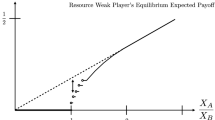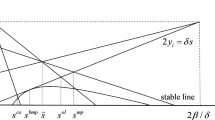Abstract
Our objective is to analyze the relationship between the Shapley value and the core of cooperative games with transferable utility. We first characterize balanced games, i.e., the set of games with a nonempty core, through geometric properties. We show that the set of balanced games generates a polyhedral cone and that a game is balanced if and only if it is a nonnegative linear combination of some simple games. Moreover, we show that the set of games whose Shapley value lies in the core also yields a polyhedral cone and that a game obeys this property if and only if it is a nonnegative linear combination of simple games satisfying certain properties. By-products, we also show that the number of games that correspond to the extreme rays of the polyhedron coincides with the number of minimal balanced collections.
Similar content being viewed by others
Notes
Shapley and Shubik (1954) apply the Shapley value to evaluate the distribution of power among the members of a committee system. Hart and Moore (1990) use the Shapley value as each agent’s payoff to analyze the incomplete contract model. Gul (1989), Pérez-Castrillo and Wettstein (2001) and McQuillin and Sugden (2016) provide implementation procedures for obtaining the Shapley value as the subgame perfect equilibrium outcome of the game.
Consistency properties play a central role in axiomatic characterizations of the core. Davis and Maschler (1965), Moulin (1985), Peleg (1986), and Tadenuma (1992) introduce different types of consistencies and axiomatize the core. Abe (2017) axiomatically characterizes the core for games with externalities. Perry and Reny (1994) offer a noncooperative game in which a core element is implemented.
Average convexity is also analyzed by Sprumont (1990). He calls it quasiconvexity in his work. However, his approach is totally different from those of Inarra and Usategui (1993); Izawa and Takahashi (1998). He defines the Shapley value for every subset of the grand coalition and considers an allocation scheme for all possible coalitions. He shows that an allocation scheme is population monotonic for every quasiconvex game.
We discuss their conditions in Sect. 4.
A solution \(f: {\mathcal {G}}_N \rightarrow {\mathbb {R}}^n\) is linear if for every \(c, c' \in {\mathbb {R}}\) and \(v, v' \in {\mathcal {G}}_N, f(cv+c'v')= cf(v)+c'f(v')\). Harsanyi’s dividend was proposed by Harsanyi (1959).
The explicit description of each extreme point in general n-player games is still open. This is because it is generally difficult to construct extreme points of a convex polyhedron. Peleg (1965) provides an algorithm to calculate all extreme points.
For every \(a, b \in {\mathbb {R}}^k\), \(a \cdot b=\sum ^k_{i=1}a_ib_i\) is a standard inner product in \({\mathbb {R}}^k\).
In this result, (1) \(\Rightarrow\) (2) is known as Minkowski’s Theorem, and the converse, (2) \(\Rightarrow\) (1), is known as Weyl’s Theorem. For details, see Ziegler (1995).
A game v is 0-normalized if \(v(\{i\})=0\) for all \(i \in N\).
A game v is simple if \(v(S)=0\) or 1 for all \(S \subseteq N\). A player \(i \in N\) is a veto player in v if \(v(S)=0\) for every \(S \subset N \setminus \{i\}\). A game v is veto-controlled if there is a veto player in v. A game v is N-monotonic if \(v(S) \le v(N)\) for all \(S \subseteq N\). See also Derks (1987) and discussions in Sprumont (1990).
In the decision theory literature, Dillenberger and Sadowski (2019) propose a similar concept, which they call generalized partition.
Formally, a game \(v \in {\mathcal {G}}_{N}\) is convex if for every \(S, T \subseteq N\), \(v(S \cup T)+v(S \cap T) \ge v(S)+v(T)\), and is average convex if for every nonempty \(S,T\subseteq N\) with \(S\subseteq T\), \(\sum _{j\in S}(v(T)-v(T{\setminus } \{j\}))\ge \sum _{j\in S}(v(S)-v(S{\setminus } \{j\}))\). Note that convexity implies average convexity. For a counter-example of the opposite direction, see examples in Inarra and Usategui (1993) and Izawa and Takahashi (1998).
We would like to thank an anonymous referee for suggesting that we consider this issue.
Various linear solutions are intensively studied as a complement to or a counterpart of the Shapley value: for example, weighted Shapley values (Shapley 1953a; Chun 1988, 1991; Kalai and Samet 1987; Nowak and Radzik 1995; Yokote 2015), egalitarian Shapley values and their generalization (Joosten 1996; Casajus and Huettner 2013, 2014; van den Brink et al. 2013; Abe and Nakada 2019; Yokote and Funaki 2018), and the CIS/ENSC value (Driessen and Funaki 1991). See also Yokote et al. (2017) for other solutions.
References
Abe T (2017) Consistency and the core in games with externalities. Internat J Game Theory 47:133–154
Abe T (2019) Decomposing a balanced game: a necessary and sufficient condition for the nonemptiness of the core. Econ Lett 176:9–13
Abe T, Nakada S (2019) The Weighted-egalitarian Shapley Values. Soc Choice Welf 52(2):197–213
Bondareva ON (1963) Some applications of linear programming methods to the theory of cooperative games. Problemi Kibernitiki 10:119–139
Casajus A (2011) Differential Marginality, van den Brink Fairness, and the Shapley Value. Theor Decis 71:163–174
Casajus A (2014) The Shapley value without efficiency and additivity. Math Soc Sci 68:1–4
Casajus A, Huettner F (2013) Null players, solidarity, and the Egalitarian Shapley values. J Math Econ 49:58–61
Casajus A, Huettner F (2014) Weakly monotonic solutions for cooperative games. J Econ Theory 154:162–172
Casajus A, Yokote K (2017) Weak differential marginality and the Shapley value. J Econ Theory 167:274–284
Chun Y (1988) The proportional solution for rights problems. Math Soc Sci 15:231–246
Chun Y (1991) On the symmetric and weighted Shapley values. Internat J Game Theory 20:183–190
Davis M, Maschler M (1965) The Kernel of a cooperative game. Naval Research Log Q 12:223–259
Derks JJ (1987) Decomposition of games with non-empty core into veto-controlled simple games. Oper Res Spekt 9(2):81–85
Dillenberger D, Sadowski P (2019) Stable behavior and generalized partition. Econ Theor 68(2):285–302
Driessen TSH, Funaki Y (1991) Coincidence of and collinearity between game theoretic solutions. OR Spect 13:15–30
Edomons J (1970) Submodular Functions, Matroids, and Certain polyhedra. In: Guy R ey al. (Eds)Combinatorial structures and their applications, pp. 69–87, Gordon & Breach, New York
Gul F (1989) Bargaining foundations of Shapley value. Econometrica 57:81–95
Harsanyi JC (1959) A bargaining model for the cooperative n-person game. In: Contributions to the Theory of Games IV (Annals of Mathematics Studies 40), eds. by A. W. Tucker and D. R. Luce. Princeton: Princeton University Press, 325–355
Hart O, Moore J (1990) Property rights and the nature of the firm. J Polit Econ 98:1119–1158
Hoffmann M, Sudhölter P (2007) The Shapley value of exact assignment games. Internat J Game Theory 35(4):557–568
Ichiishi T (1981) Super-modularity: applications to convex games and to the greedy algorithm for LP. J Econ Theory 25(2):283–286
Inarra E, Usategui JM (1993) The Shapley value and average convex games. Internat J Game Theory 22:13–29
Izawa Y, Takahashi W (1998) The coalitional rationality of the Shapley value. J Math Anal Appl 220:597–602
Joosten R (1996) Dynamics, equilibria, and values. Dissertation, Maastricht University
Kalai E, Samet D (1987) On weighted Shapley values. Internat J Game Theory 16:205–222
Marinacci M, Montrucchio L (2004) A characterization of the core of convex games through gateaux derivatives. J Econ Theory 116:229–248
McQuillin B, Sugden R (2016) Backward induction foundations of the Shapley value. Econometrica 84:2265–2280
Moulin H (1985) The separability axiom and equal-sharing methods. J Econ Theory 36:120–148
Nowak A, Radzik T (1995) On axiomatizations of the weighted Shapley values. Games Econom Behav 8:389–405
Peleg B (1965) An inductive method for constructing minimal balanced collections of finite sets. Naval Res Log Q 12(2):155–162
Peleg B (1986) On the reduced game property and its converse. Internat J Game Theory 15:187–200
Peleg B, Sudhölter P (2007) Introduction to the theory of cooperative games. Springer, New York
Pérez-Castrillo D, Wettstein D (2001) Bidding for the surplus: a non-cooperative approach to the Shapley value. J Econ Theory 100:274–294
Perry M, Reny PJ (1994) A noncooperative view of coalition formation and the core. Econometrica 62:795–817
Shapley L (1953a) Additive and non-additive set functions. Ph.D. Thesis, Department of Mathematics, Princeton University
Shapley L (1953b) A Value for n-Person Games. In: Contributions to the Theory of Games II (Annals of Mathematics Studies 28), eds. by H. W. Kuhn and A. W. Tucker. Princeton: Princeton University Press, 307–317
Shapley L (1967) On balanced sets and cores. Naval Res Log Q 14:453–460
Shapley L (1971) Cores of convex games. Internat J Game Theory 1:11–26
Shapley L, Shubik M (1954) A method of evaluating the distribution of power in a committee system. Am Polit Sci Rev 48:787–792
Sprumont Y (1990) Population Monotonic allocation schemes for cooperative games with transferable utility. Games Econ Behav 2:378–394
Tadenuma K (1992) Reduced games, consistency, and the core. Internat J Game Theory 20:325–334
van den Brink R, Funaki Y, Ju Y (2013) Reconciling marginalism with egalitarianism: consistency, monotonicity, and implementation of egalitarian shapley values. Soc Choice Welf 40:693–714
Young P (1985) Monotonic solutions of cooperative games. Internat J Game Theory 14:65–72
Yokote K (2015) Weak addition invariance and axiomatization of the weighted Shapley value. Internat J Game Theory 44:275–293
Yokote K, Funaki Y (2018) Monotonicity implies linearity: characterizations of convex combinations of solutions to cooperative games. Soc Choice Welf 49:171–203
Yokote K, Kongo T, Funaki Y (2017) The balanced contributions property for equal contributors. Games Econ Behav 108:113–124
Yokote K, Funaki Y, Kamijo Y (2016) A new basis and the shapley value. Math Soc Sci 80:21–24
Ziegler GM (1995) Lectures on polytopes graduate texts in mathematics, vol 152. Springer, New York
Author information
Authors and Affiliations
Corresponding author
Ethics declarations
Conflict of interest
This study was funded by the Japan Society for the Promotion of Science KAKENHI: Nos. 19K23206, 22K13362 (Abe) and No. 19K13651 (Nakada). The authors have no financial or proprietary interests in any material discussed in this article and there is no competing interest to declare.
Additional information
Publisher's Note
Springer Nature remains neutral with regard to jurisdictional claims in published maps and institutional affiliations.
We thank an associate editor and an anonymous referee for their valuable comments. We are also grateful to Yukihiko Funaki, Toshiyuki Hirai, Stephen Morris, Takashi Ui, Jun Wako, three anonymous referees of the Kanematsu Fellowship, and participants of various seminars and conferences. This paper is a substantially revised version of our previous paper circulated as “Generalized Potentials, Value, and Core”, which received the Kanematsu Fellowship from the Research Institute for Economics and Business Administration of Kobe University in 2017. Abe and Nakada acknowledge the financial support from Japan Society for the Promotion of Science KAKENHI: Nos. 19K23206, 22K13362 (Abe), and No. 19K13651 (Nakada). All remaining errors are our own.
Supplementary Information
Below is the link to the electronic supplementary material.
Rights and permissions
Springer Nature or its licensor holds exclusive rights to this article under a publishing agreement with the author(s) or other rightsholder(s); author self-archiving of the accepted manuscript version of this article is solely governed by the terms of such publishing agreement and applicable law.
About this article
Cite this article
Abe, T., Nakada, S. Core stability of the Shapley value for cooperative games. Soc Choice Welf 60, 523–543 (2023). https://doi.org/10.1007/s00355-022-01432-4
Received:
Accepted:
Published:
Issue Date:
DOI: https://doi.org/10.1007/s00355-022-01432-4




